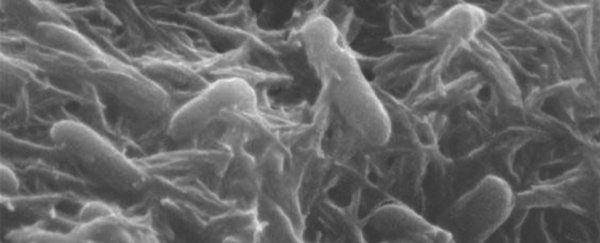A bacterial species that survives by 'breathing' rock has intrigued scientists for decades, even though the inner workings of its mysterious cellular respiration technique have remained far from clear.
Now, in a new study investigating the strange habits of the bacterium Shewanella oneidensis, researchers have discovered that the microbe's ability to 'breathe' by transporting electrons externally to solid surfaces is influenced by molecular chirality, which induces an optimal direction of electron spin as the organism 'exhales'.
This phenomenon appears to help S. oneidensis (aka S. oneidensis MR-1) to exist in environments with little or no oxygen, discarding electrons in anaerobic conditions, such as rocky and metallic habitats deep underground.
"Unlike most organisms that are able to use oxygen as the electron acceptor, these bacteria transfer the electrons to a solid mineral or, as they do in our lab, to electrodes that are outside the cell," explains biomedical engineer Sahand Pirbadian biomedical engineer Sahand Pirbadian from the University of Southern California (USC).
S. oneidensis was first identified back in the 1980s, with scientists isolating the microbe in sediment taken from Oneida Lake in New York. Researchers soon found the metal-munching microbe could extract energy from minerals in airless conditions – a trick that enables it to do things like power microbial fuel cells and produce the 'wonder material' graphene.
But how does this nifty survival strategy actually work? For a long time, it was thought that S. oneidensis transported electrons to its external environment via hair-like 'bacterial nanowires' that acted as a conduit and literal lifeline to offload electrons.
"If you don't give it an electron acceptor, it dies," USC microbiologist Kenneth Nealson, who helped first discover S. oneidensis decades ago, explained in 2010. "It dies pretty rapidly."
In recent years though, USC researchers found that these bacterial nanowires weren't hair-like protrusions of the cell (known as pili), but something else entirely: membrane extensions featuring electron-carrying proteins called cytochromes.
"The pili idea was the strongest hypothesis, but we were always cautious because the exact composition and structure were very elusive," USC microbiologist Moh El-Naggar said in 2014. "In many ways, it turned out to be an even cleverer way for bacteria to power themselves."
In subsequent work, El-Naggar's lab team discovered that the structure of the nanowires resembled a string of pearls, with the cytochrome proteins effectively floating along the chain, transporting electrons through a combination of direct electron hopping and diffusion of electron carriers.
Now, the group has revealed another insight. In their new study, the researchers found that as electrons are transported along the nanowire, their direction of electron spin – a quantum phenomenon describing their angular momentum – seems to be influenced by the chirality (left- or right-handedness) of the cytochrome molecules. This is due to the polarity of magnetic fields that are themselves determined by the chirality.
"By the time the electrons traverse the molecule wire, the majority end up having the same quantum spin – up or down – depending on the chirality," says El-Naggar.
"This study is the first to confirm that the electrically conductive proteins in these cells are selecting the spin of electrons."
This effect, called chiral induced spin selectivity (CISS), might stand to do much more than just optimise the efficiency of electron transport during the cellular respiration of S. oneidensis.
Ultimately, the researchers say, if we can understand these processes well enough, we might be able to harness the mechanism in spintronics technologies, which promise to offer vastly more powerful devices than conventional computers.
We're not there yet, but thanks to this new understanding of the intricate structures used by S. oneidensis, we're getting closer.
"There is an ongoing hunt for materials that can serve as the basis for new spintronic technologies," El-Naggar explains. "Our work shows that bacterial cytochromes may be interesting candidates for spintronics."
The findings are reported in Journal of the American Chemical Society.
